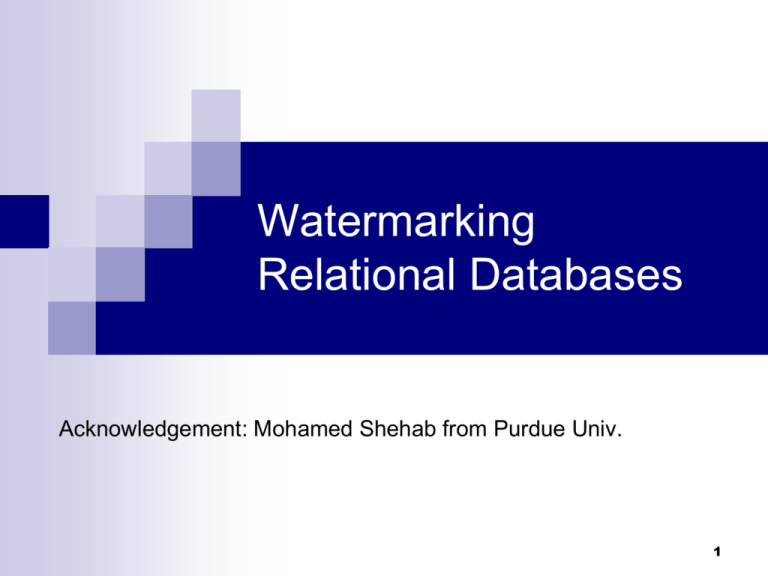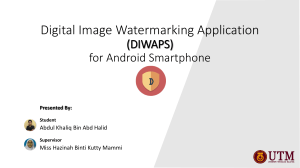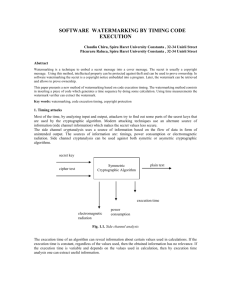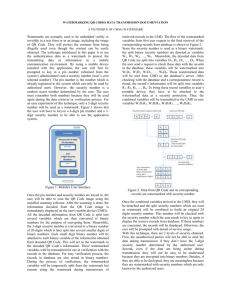Watermarking Relational Databases
advertisement

Watermarking
Relational Databases
Acknowledgement: Mohamed Shehab from Purdue Univ.
1
Outline
Introductory Material
General Watermarking Model & Attacks
WM Technique 1 (Agrawal et al.)
WM Technique 2 (Sion et al.)
Future Challenges and References
2
What is Watermarking ?
A “watermark” is a signal that is securely,
imperceptibly, and “robustly” embedded
into original content such as an image,
video, or audio signal, producing a
watermarked signal.
The watermark describes information that
can be used for proof of ownership or
tamper proofing.
3
What is Watermarking ? (Cont.)
Watermark
Robust
Fragile
Robust Watermark: for proof of ownership,
copyrights protection.
Fragile Watermark: for tamper proofing, data
integrity.
4
Why Watermarking ?
Digital Media (Video, Audio, Images, Text) are
easily copied and easily distributed via the web.
Database outsourcing is a common practice:
Stock
market data
Consumer Behavior data (Walmart)
Power Consumption data
Weather data
Effective means for proof of authorship.
Signature
and data are the same object.
Effective means of tamper proofing.
Integrity
information is embedded in the data.
5
Why is Watermarking Possible ?
Real-world datasets can tolerate a small
amount of error without degrading their
usability
Meteorological
data used in building weather
prediction models, the wind vector and temperature
accuracies in this data are estimated to be within 1.8
m/s and 0.5 ºC.
Such
constraints bound the amount of change or
alteration to that can be performed on the data.
6
What defines the usability constraints ?
Usability constraints are application
dependent.
Alterations
performed by the watermark
embedding should be unidentifiable by the
human visual system in images/video.
For consumer behavior data: watermarking
should preserve periodicity properties of the
data.
7
What defines the usability constraints ? (Cont.)
Courtesy of http://maps.google.com
8
Watermark Desirable Properties
Detectability (Key-Based System)
Can
be easily detected only with the knowledge of the
secret key.
Robustness
Watermark
cannot be easily destroyed by modifying
the watermarked data.
Imperceptibility
Presence
of the watermark is unnoticeable.
Blind System
Watermark
detection does not require the knowledge
of the original data.
9
Outline
Introductory Material
General Watermarking Model & Attacks
WM Technique 1 (Agrawal et al.)
WM Technique 2 (Sion et al.)
Future Challenges and References
10
Watermarking Model
Watermark
W=(100100100….)
Watermark
Encoder
Watermarked
Data, DW
Attacker
Channel
Attacked
Data, D’W
Watermark
Decoder
Data, D
Secret Key, Ks
Decoded Watermark
WD=(100100100….)
11
Relational and multimedia data
A multimedia object consists of a large number of bits,
with considerable redundancy. Thus, the large
watermark hiding bandwidth.
The relative spatial/temporal positioning of various
pieces of a multimedia object typically does not change.
Tuples of a relation on the other hand constitute a set
and there is no implied ordering between them.
Portions of a multimedia object cannot be dropped or
replaced arbitrarily without causing perceptual changes
in the object. However, a pirate of a relation can simply
drop some tuples or substitute them with tuples from
other relations.
12
Attacker Model
Attacker has access to only the
watermarked data set.
The attacker’s goal is to weaken or even
erase the embedded watermark and at the
same time keep the data usable.
“Attacker’s Dilemma”
Possible Attacks
Tuple
deletion
Tuple alteration
Tuple insertion
13
Outline
Introductory Material
General Watermarking Model & Attacks
WM Technique 1 (Agrawal et al.)
WM Technique 2 (Sion et al.)
Future Challenges and References
14
WM Technique 1 (Agrawal et. al.)
Watermarking of numerical data.
Technique dependent on a secret key.
Uses markers to locate tuples to hide
watermark bits.
Hides watermark bits in the least
significant bits.
15
WM Technique 1: Encoder
Watermark
W=(100100100….)
Watermark
Encoder
Watermarked
Data, DW
Attacker
Channel
Attacked
Data, D’W
Watermark
Decoder
Data, D
Secret Key, Ks
Decoded Watermark
WD=(100100100….)
Instead:
Watermark is a function of the data and the secret key
16
WM Technique 1: Encoder
Assumptions
K,
e, m and v are selected by the data owner and
are kept secret.
“K” is the secret key.
“e” least significant bits can be altered in a
number without affecting its usability. Example,
e=3, 101101101.1011101
“m” used for marker selection and 1/m is fraction
of tuples marked
“v” is the number of attributes used in the
watermarking process.
17
Message Authentication Code
One way hash function H operates on an input message
M of arbitrary length and returns a fixed length of has
value h.
Three characteristics
Given M, it is easy to compute h
Given h, it is hard to compute M
Give M, it is hard to find another message M’ such that H(M) =
H(M’)
A message authentication code (MAC) is a one-way has
function that depends on a key.
MAC(r.P) = MAC(r.P) = H(K || MAC(K||r.P)
r.P is the primary key attribute of relation r, K is a secret
key known only to owner, and output is an integer value
in a wide range.
18
WM Technique 1: Encoder
For all tuples r in D
MAC(r.P) = MAC(r.P) = H(K || MAC(K||r.P)
if(MAC(r.P) mod m == 0)
// Marker Selection
i = (MAC(r.P) mod v
b = (MAC(r.P) mod e
if((MAC(r.P) mod 2 == 0)
// Selected Attribute
// Selected LSB index
// MAC is even
Set bit b of r.Ai
Else
Clear bit b of r.Ai
19
WM Technique 1 : Encoder
(MAC mod v=1
MAC mod m
PKey
1
1234
4
2345
0
3390
9
4455
Attribute 0
Attribute 1
……….
Attribute v-1
1010101010.010111011
MAC is MAC(K || MAC(K || r.P))
MAC mod e
20
WM Technique 1 : Decoder
Watermark
W=(100100100….)
Watermark
Encoder
Watermarked
Data, DW
Attacker
Channel
Attacked
Data, D’W
Watermark
Decoder
Data, D
Secret Key, Ks
Decoded Watermark
WD=(100100100….)
21
WM Technique 1 : Decoder
Match = Total_Count = 0
For all tuples r in D
r.MAC = H(K||r.P||K)
if(r.MAC mod m == 0)
Total_Count++
i = r.MAC mod v
// Selected Attribute
b = r.MAC mod e
// Selected LSB index
if(r.MAC mod 2 == 0) // MAC is even
if bit b of r.Ai is Set
Match++
Else
// Marker Selection
If bit b of r.Ai is Clear
Match++
Compare (Match/Total_count) > Threshold
22
WM Technique 1 : Decoder
MAC mod v
MAC mod m
PKey
1
1234
4
2345
0
3390
9
4455
Attribute 0
Attribute 1
……….
Attribute v-1
1010101010.010111011
MAC is MAC(K || MAC (K || r.P))
MAC mod e
23
WM Technique 1 : Strengths
Computationally efficient O(n)
Tuple
sorting not required.
Incremental Updatability
24
WM Technique 1 : Weaknesses
No provision of multi-bit watermark, all
operations are dependent only on the secret
key.
Not resilient to alteration attacks. Least
Significant Bit (LSB) can be easily manipulated
by simple numerical alterations
Shift
LSB bits to the right/left.
Requires the presence of a primary key in the
watermarked relation.
Does not handle other usability constraints such
as:
Category
preserving usability constraints.
25
Outline
Introductory Material
General Watermarking Model & Attacks
WM Technique 1 (Agrawal et al.)
WM Technique 2 (Sion et al.)
Future Challenges and References
26
WM Technique 2 :(Sion et. al.)
Watermarking of numerical data.
Technique dependent on a secret key.
Instead of primary key uses the most
significant bits of the normalized data set.
Divides the data set into partitions using
markers.
Varies the partition statistics to hide
watermark bits.
27
WM Technique 2 : Encoder
Watermark
W=(100100100….)
Watermark
Encoder
Watermarked
Data, DW
Attacker
Channel
Attacked
Data, D’W
Watermark
Decoder
Data, D
Secret Key, Ks
Decoded Watermark
WD=(100100100….)
28
WM Technique 2: How to hide a
single bit in a number set ?
Problem:
“ Given a number set Si = {s1,…,sn}, how to vary
their statistics to embed bit bi. Subject to the
provided usability constraints.”
29
Paper 2: How to hide a single bit in
a number set ?
Definitions
ref
= mean(Si)
= stdev(Si).
ref = + c, c is a confidence factor
Vc(Si) = number of points greater than ref. We refer to
them as ”positive violators”.
30
Paper 2: How to hide a single bit in
a number set ?
ref
Insert bi = 1
Bit = 0
0
Invalid
|Si|*Vfalse
Bit = 1
|Si|*Vtrue
|Si|
31
WM Technique 2: How to avoid
using the primary key ?
a number set Si = {s1,…,sn},
generate Norm(Si) = Si / max(Si).
Given
For
each number in sk in Norm(Si)
use the first n most significant bits
(MSB) as the primary key for sk.
32
WM Technique 2 : Encoder
Step 1: (Sorting)
Compute the MAC of each tuple:
r.MAC = H(K || r.P || K)
// r.P = MSB(r.A)
Sort tuples in ascending order using the computed
MAC.
Step 2: (Partitioning)
Locate
markers: tuples with
r.MAC mod m = 0
Tuples between two markers are in the same
partition.
Step 3: (Bit Embedding):
Embed
a watermark bit in each partition using the bit
embedding technique discussed earlier.
33
WM Technique 2 : Encoder
0
1
0
1
1
Step 1
Sort Ascending
According to MAC
Step 2
Locate Markers
r.MAC mod m = 0
Step 3
Bit Embedding
34
WM Technique 2 : Decoder
Watermark
W=(100100100….)
Watermark
Encoder
Watermarked
Data, DW
Attacker
Channel
Attacked
Data, D’W
Watermark
Decoder
Data, D
Secret Key, Ks
Decoded Watermark
WD=(100100100….)
35
WM Technique 2 : Decoder
Step 1: (Sorting & Partitioning)
Partition
data set using the same approach
used in the encoding phase.
Step 2: (Bit Detection)
For
each partition Si compute Vc(Si) and
decode the embedded bit.
Step 3: (Majority Voting):
Watermark
bits are embedded in several
partitions use majority voting to correct for
errors.
36
WM Technique 2 : Decoder
0
1
1
ref
1
Bit = 0
0
Invalid
|Si|*Vfalse
Bit = 1
|Si|*Vtrue
|Si|
0
Watermarked
Data Set
Majority Voting
37
WM Technique 2 : Strengths
Bit embedding technique honors usability
constraints.
Embeds watermark in data statistics which
makes technique more resilient to
alteration attacks compared with Least
Significant Bits (LSB).
38
WM Technique 2 : Watermark Synchronization
Error (Tuple Addition)
5
4
3
2
1
0
W0
W1
W2
1
1
1
0
0
0
1
1
0
1
0
0
1
1
1
0
0
1
Wresult
1
0
1
0
1
0
5
4
3
2
1
0
W0
W1
W2
0
0
0
1
1
0
1
0
0
1
1
1
1
0
1
0
1
1
Wresult
0
1
0
1
1
1
0
1
1
1
1
1
0
.
.
.
Watermarked
Data Set
39
WM Technique 2 : Watermark Synchronization
Error (Tuple Deletion)
0
1
1
1
5
4
3
2
1
0
W0
W1
W2
1
1
1
0
0
0
1
1
0
1
0
0
1
1
1
0
0
1
Wresult
1
0
1
0
1
0
W0
W1
W2
0
1
x
1
1
1
0
0
0
1
1
0
1
0
0
1
1
1
Wresult
x
1
0
1
0
1
1
0
.
.
.
Watermarked
Data Set
40
Paper 2: Weaknesses
Watermark suffers badly from watermark
synchronization error cause by
Tuple
deletion attacks.
Tuple addition attacks.
No optimality criteria when choosing the
decoding thresholds
Errors
even in absence of attacker.
No clear systematic approach for manipulating
data
Only
a very small space of the feasible data
manipulations investigated.
41
Outline
Introductory Material
General Watermarking Model & Attacks
WM Technique 1 (Agrawal et al.)
WM Technique 2 (Sion et al.)
Future Challenges and References
42
Challenges
Investigate watermarking other types of
data. Such as data streams.
Design robust watermarking techniques
that are resilient to watermark
synchronization errors.
Design a fragile watermarking technique
for relational databases.
43
References
J. Kiernan, R. Agrawal, "Watermarking
Relational Databases," Proc. 28th Int'l Conf.
Very Large Databases VLDB, 2002.
Radu Sion, Mikhail Atallah, Sunil Prabhakar,
"Rights Protection for Relational Data," IEEE
Transactions on Knowledge and Data
Engineering, Volume 16, Number 6, June 2004
44
Questions?
45







